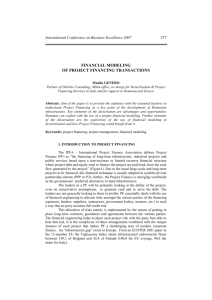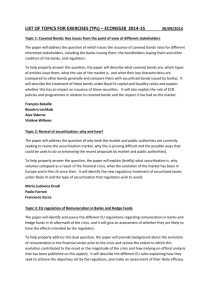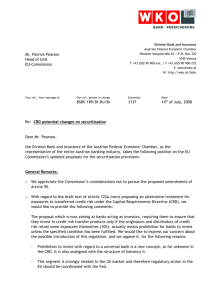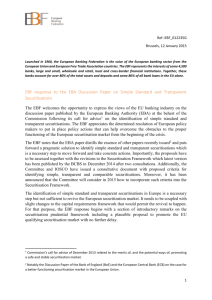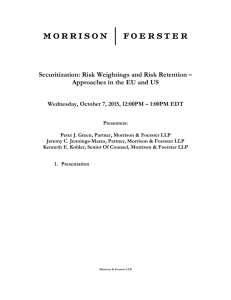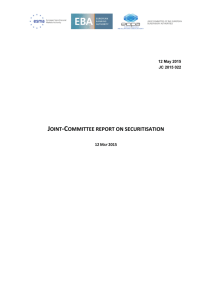Securitisation as a Financing Technique in the Social Housing Market
advertisement
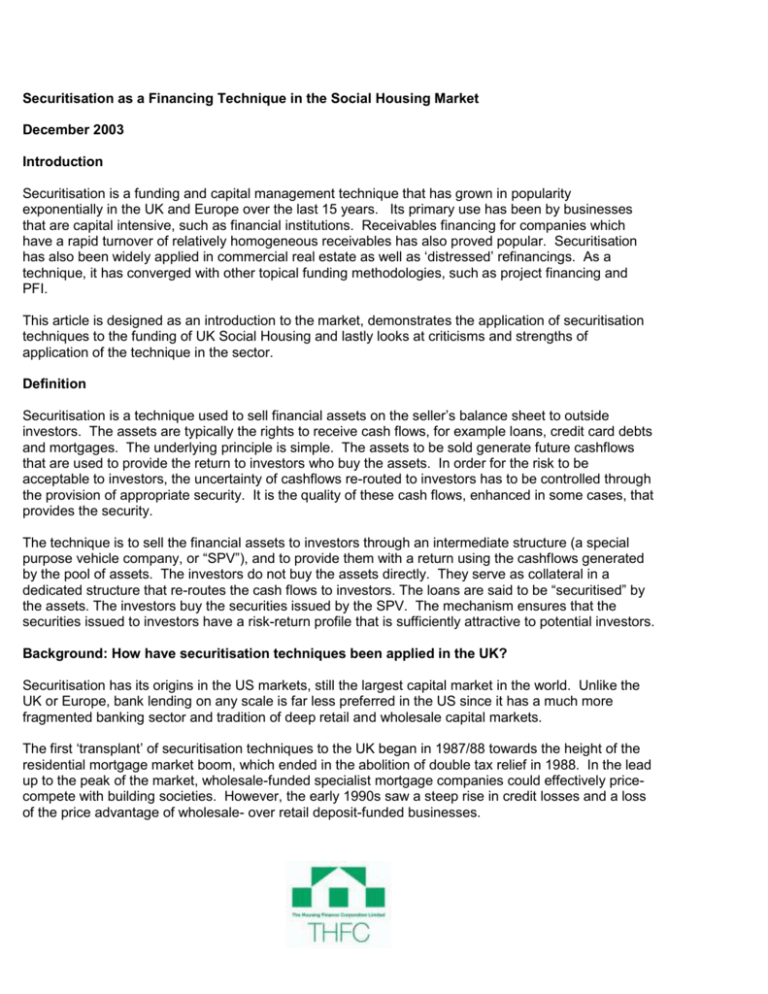
Securitisation as a Financing Technique in the Social Housing Market December 2003 Introduction Securitisation is a funding and capital management technique that has grown in popularity exponentially in the UK and Europe over the last 15 years. Its primary use has been by businesses that are capital intensive, such as financial institutions. Receivables financing for companies which have a rapid turnover of relatively homogeneous receivables has also proved popular. Securitisation has also been widely applied in commercial real estate as well as ‘distressed’ refinancings. As a technique, it has converged with other topical funding methodologies, such as project financing and PFI. This article is designed as an introduction to the market, demonstrates the application of securitisation techniques to the funding of UK Social Housing and lastly looks at criticisms and strengths of application of the technique in the sector. Definition Securitisation is a technique used to sell financial assets on the seller’s balance sheet to outside investors. The assets are typically the rights to receive cash flows, for example loans, credit card debts and mortgages. The underlying principle is simple. The assets to be sold generate future cashflows that are used to provide the return to investors who buy the assets. In order for the risk to be acceptable to investors, the uncertainty of cashflows re-routed to investors has to be controlled through the provision of appropriate security. It is the quality of these cash flows, enhanced in some cases, that provides the security. The technique is to sell the financial assets to investors through an intermediate structure (a special purpose vehicle company, or “SPV”), and to provide them with a return using the cashflows generated by the pool of assets. The investors do not buy the assets directly. They serve as collateral in a dedicated structure that re-routes the cash flows to investors. The loans are said to be “securitised” by the assets. The investors buy the securities issued by the SPV. The mechanism ensures that the securities issued to investors have a risk-return profile that is sufficiently attractive to potential investors. Background: How have securitisation techniques been applied in the UK? Securitisation has its origins in the US markets, still the largest capital market in the world. Unlike the UK or Europe, bank lending on any scale is far less preferred in the US since it has a much more fragmented banking sector and tradition of deep retail and wholesale capital markets. The first ‘transplant’ of securitisation techniques to the UK began in 1987/88 towards the height of the residential mortgage market boom, which ended in the abolition of double tax relief in 1988. In the lead up to the peak of the market, wholesale-funded specialist mortgage companies could effectively pricecompete with building societies. However, the early 1990s saw a steep rise in credit losses and a loss of the price advantage of wholesale- over retail deposit-funded businesses. Since this introduction, securitisations have been completed for the following asset classes: Residential mortgages Mortgages in arrears Auto loans (finance company/bank loans to purchase cars) Lease receivables (for instance small-ticket commercial lease contracts e.g for photocopiers) Personal loans Point of sale financing Credit card receivables Trade receivables financings Commercial real estate Big ticket leases (e.g. aircraft/ships) Wholesale loan portfolios (typically diversified bank loan portfolios) Whole business securitisations Broadcasting/royalty rights Last but not least: Social housing receivables This is a broad but not exhaustive list designed to show the breadth of application of the technique. Securitisation works best with large well-diversified, homogenous asset pools. Multi-jurisdictional financings have been completed, but tend to be expensive to document. English law serves well with its long established precedents in company, trust and tax laws. The rationale for considering securitisation as well as other financing techniques It is typically threefold: o o o Capital efficiency Funding diversification Distressed financing RSLs don’t tend to be primarily driven by capital efficiency. There is no equivalent to the Basel capital adequacy regime, which sets minimum capital requirements for banks’ lending activities, for Housing Associations (yet!). Equally, the sector has an extremely good credit track-record. RSLs are regulated and are perceived/view themselves as a “zero-loss” sector, manifested by predictable revenue streams and watched over by the Housing Corporation. Why then would securitisation be relevant to them? The answer lies in the potentially loan-capital intensive nature of RSL development activity and the need to underpin the supply of assured investment funds needed to support a long term business. Undiversified RSLs are (arguably) counter-cyclical businesses. As the economy weakens, so demand for social housing increases. Wholesale bank funding is notoriously cyclical. Hence measures to diversify funding to include elements of capital markets funding as well as bank/building society funding should be considered prudent. Differences between securitisation and secured financing There have been a number of ‘pure’ securitisations in the social housing market: UK Rents and Housing Association Finance (“HAF”) are two whose origins date back to the mid 1990s. A primary distinction of UK Rents from later transactions is that the UK Rents SPV structure includes the right to receive all rents from properties assigned to the deal (“rental pass-through”). Pure securitisation relies on the ability both to identify and segregate cash-flows from cradle to grave. In the case of rent receivables this would, ideally, involve an ability to identify and segregate cash-flows right back to source. The majority of RSL rent receivables are received, typically, direct from councils (sometimes as many as 30 or 40 for well geographically dispersed RSLs). Those that are paid by tenants can be paid by a variety of mechanisms. Consequently, as a pure logistical/IT exercise, securitisation can prove problematic. Nevertheless the advent of increasingly sophisticated housing management systems, which typically allow an ability to track individual securitised rent receivables, could prove a positive differentiator for a variety of reasons. For RSL management, detailed accurate payment information will be increasingly important from a quality assurance point of view and good payment data can be important (as well as the more obvious bad payment data) as part of a choicebased lettings analysis. Securitisation necessarily involves the need to account accurately for the ownership and allocation of individual cash-flows and to set up dedicated bank accounts. This might involve the creation of a pure rent collection bank account that acts as a positive cash-concentration account, with strict controls over any debits to the account. At an institutional level, it will be necessary effectively to account for a company (the SPV) within a company. In this respect, two approaches are commonly adopted. The first, more old-fashioned approach is to adopt a multi-company general ledger accounting system. The second, more flexible approach is to design a set of supplementary periodic accounting entitlement reports, which detail and reconcile securitisation and company cash entitlements on a periodic basis. Both the early debenture and later benchmark bond issuance transactions, such as those by Haven and Harbour Funding, do not have an assignment over rental cash flows as part of the normal operation of the deal – instead they rely on a mortgage over the underlying income-producing collateral. Why have they remained popular as deal structures? Simplicity is key. Basic mortgage structures are straightforward to explain to RSL boards. The need to seek the financial cost-benefits which securitisation can bring have not been pressing for most RSLs. The two leading demands of sector financing in recent years have been to deliver finance on a costeffective basis and in a flexible manner. Bank financing has typically won the day. Why might this change? RSL balance sheet capacity for conventional borrowing is a key reason. A number of the largest RSLs are trending more towards project based development financing. The larger RSLs show an accelerating current (2003/4) trend for RSL mergers and have a growing need for high quality tracking of data on asset performance. These factors open the way for successful securitisations. Secured financing requires assets (usually but not always income producing assets) to be identified as providing a potential source of income to the lender to service the loans it makes. The cost and availability of such financings relies in part on the quality of the assets offered as security, but, unlike in a securitisation, access to the cash flows from operating or selling the assets is only allowed after a default by the borrower. In a secured financing the lender first has recourse to the borrower’s total cash flow and only after this fails to the securing assets. In a securitisation the lender (typically the bond investor) only has access to the securitised pool of financial assets dedicated to servicing the bonds. The role of rating agencies Debt Rating Agencies are most commonly associated with rating capital markets debt, but in reality cover all debt markets. With the advent of Basel II capital adequacy standards and the prevalence of the ‘bank-assurance’ model making banks more complicated and potentially risky businesses, the importance of credit ratings is growing. Securitisations are commonly viewed by investors as highly rated, structured financings. Both UK Rents and HAF enjoy ‘AAA’ long term ratings for the majority of debt issued, the highest credit rating available. How is this achieved when the underlying corporate ratings of most RSLs vary between ‘BBB’ and ‘A’? In the most basic terms, a ‘AAA’ rated debt security is an obligation which, either through core financial strength or ‘credit enhancement’, can continue to pay both principal and interest in a full and timely way through a simulated stress-case which is modeled by the rating agency on a ‘AAA’ rated financial depression, similar to the 1930s in the US. ‘AA’ or ‘A’ rated securities can ‘survive’ less severe economic scenarios. Thus debt securities issued by an RSL with a core financial strength estimated at ‘A’ must be “credit-enhanced” to achieve a higher credit rating. This can be achieved by a variety of means. Dedicated cash reserves, acting as a standby if core asset cash flow performance fails, are a popular and simple method of credit enhancement as is ‘over-collateralisation’…the pledging of a surplus of security over that needed to service the debt. Subordinated debt (debt where holders assume a first, or more typically, a second loss position, and so suffer losses before the securitised senior debt holders) has proved a structurally robust feature of mainstream securitisations, and is commonly adopted in PFI transactions. The majority of securitised financing consortium bonds fall into the ‘AA’ category. This level is achieved typically by a combination of over-collateralisation and cash reserves to lift the constituent RSLs from their ‘core’ individual ratings. One feature deliberately not present in these structures is ‘cross collateralisation’ where the assets of one RSL may be used to meet the liability from a shortfall in the performance of the assets of another RSL. Contingent obligations to support other RSLs in a long term financing structure, whilst adding aggregate strength to a bond, are typically viewed as a bad precedent (for sensible reasons). Rating agencies are most intensively involved at the outset of a transaction. However ratings are continuously monitored and for different reasons can be modified during the life of a bond issue. If a collateral pool were modified significantly during the life of a transaction (e.g. through significant right-to buy obligations), then this might cause a transaction to go on “credit-watch” pending the substitution of alternative collateral. Equally a material weakening of the financial position of a key element in the deal (for instance a guarantor of the first losses) might have a similar effect. Highly rated securitisations necessarily insulate themselves as far as possible from the financial weakening of their sponsor ( the RSL). The logical limit of this is the ability of the financial structure to withstand the insolvency/ receivership of the sponsor RSL entirely. Typically this requirement would need to assume a ready substitute housing manager of the property acting as security (a relatively straightforward assumption for all but the largest RSLs). Criticisms of securitisation o o o Complicated to administer. This criticism can be levelled at secured financing as much as securitisations. A key quality of a successful financing must be that it is straightforward for the steward of the financing (the RSL or administrative agent) to track the collateral’s performance. Early warning indicators are key to anticipating adverse trends. Conversely, RSLs who invest the time and effort in developing good MIS systems can gain a competitive advantage. They understand the performance of their collateral better and can identify developing financial trends more quickly. High fixed costs. Early adopters incur these costs…principally legal costs. Inevitably, ‘going it alone’ in developing new structures, whether pure securitisation or not, involves high costs. Consortium structures are a sensible hedge against this. ‘Cherry-picking’. In any secured financing business securitisation will be looked on dimly by existing secured creditors because the assets which underpin the securtisation may be the most reliable cash flow generators and after the securitisation will be lost to the pre-existing secured creditors. For this reason existing lenders may have imposed a financial covenant that precludes securitisations. Long term financial covenant planning plays an important part in preempting existing lender objections. The only banker who will not complain is the one earning the fees from the securitisation. In general, there is only short term advantage for a business looking to create a periodic, rather than one off, securitisation funding stream. In the long run, it is best to ring-fence a representative sample of the entire asset book to meet securitisation needs. Benefits of securitisation o o o o o Diversifies funding away from a tightly knit group of mortgage banks/building societies. Future-proofs availability of financing. RSL mergers do not affect the strength of investors appetites Funding is available across the economic cycle. Banks tend to draw in their horns during downturns and they can also do this for unforeseen reasons, not connected to the performance of an RSL Frees up flexible banking lines rather than filling the whole credit appetite of a bank with long term loans. Produces a rigorous internal financial monitoring regime. Early warning indicators can act as a strong guide to regulator and board alike. Management information derived for securitisation transactions can provide an incisive insight into the business and in benchmarking against peer group RSLs. These factors combine to make a securitisation one of the more attractive funding routes for Housing Associations looking to raise funds in the capital markets. A securitisation may be a more asset efficient and flexible way for funding new build or refinancing exisiting debt. The writer is happy to answer any queries you may have on this attractive funding route. Piers Williamson Tel: 020 7282 1110 E: Piers.Williamson@thfcorp.com Acknowledgement The writer is Chief Executive of The Housing Finance Corporation. He has been actively involved in the UK securitisation market since its inception in 1988 and has been involved with, or created securitisation programmes for, residential mortgage assets, consumer loans and as credit cards. THFC provides administrative services to a number of third party secured financings/securitisations in the social housing sector including: UK Rents, Haven Funding/Haven 32, Sunderland Housing Finance and Harbour Funding.



